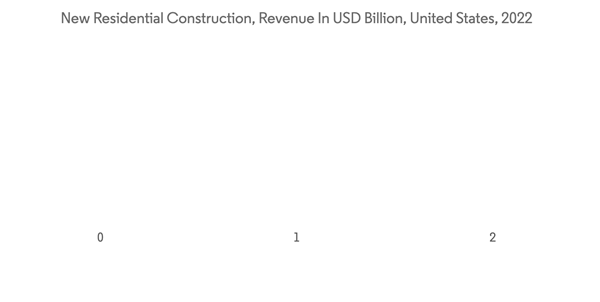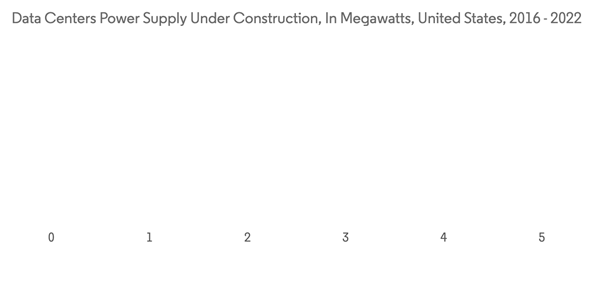Key Highlights
- Over the years, the North American wire and cable industry has witnessed significant growth driven by the rapid development of infrastructure, along with the growing demand for electricity and internet connectivity among households. Furthermore, the increasing investment in clean and renewable energy infrastructure continues to remain among the major driving factors for the market's growth. For instance, according to the Business Council for Sustainable Energy (BCSE) organization, investments in clean energy in the United States increased from USD 56 billion in 2022 to USD 141 billion in 2022.
- In recent years, there has been a rapid increase in economic activity and urbanization in North America. For instance, according to the Population Reference Bureau, the share of the urban population is the highest in North America (83% in 2022) compared to any other continent, which is driving the growth of the construction and infrastructure sectors, as well as the industrial sector. The demand from various sectors, such as commercial, residential, telecom, industrial, and energy and power, is leading to the expansion and upgradation of the infrastructure. Additionally, the refurbishment of aging infrastructure also supports the market's growth.
- Furthermore, factors such as increasing reserves in smart grid technology, growing renewable energy production, and government initiatives for upgrading transmission and distribution systems are responsible for the proliferation of the wires and cables market in North America. In the past few years, content and cloud providers have also attempted to offer bandwidth-intensive services, increasing submarine infrastructure popularity in the region to attract more customers, which supports the demand for wires and cables.
- However, wire and cable manufacturing requires various types of raw materials, including metals, silicon, and insulation materials such as PVC, rubber, etc. The fluctuating raw material prices, especially the pricing for metals, challenge the market's growth.
- The outbreak of the COVID-19 pandemic had a notable impact on the growth of the market studied. While the market witnessed a slowdown in demand, especially during the initial phase, the growing adoption of digital and automation technologies during the later period was anticipated to support the market's growth.
North America Wire And Cable Market Trends
Construction Industry to be the Largest End User
- The construction segment comprises both residential and commercial in the studied scope. The wiring and cabling network are the most critical components for residential buildings, manufacturing plants, or any other type of commercial structure, as wires and cables are used to deliver power, control, data, voice communication, and security to the entire infrastructure.
- The increasing demand for wire and cables in the residential and commercial construction industry is driven by population growth and urbanization in the North American region. According to the FMI Corporation, in 2022, the new constructions built in the United States had an estimated value of almost USD 1.8 trillion. Over the last few years, construction spending has been growing steadily.
- The residential construction industry continues to grow mainly due to low mortgage rates, strong demand for bigger living quarters, and insufficient housing stock on the market. Apart from building houses, home renovations are also an essential aspect of housing construction. The annual value of upgrading homes in the United States is expected to exceed USD 205 billion by 2023. Compared to the previous four years of a boom in construction, more than 330,000 new rental units are planned for delivery nationwide.
- Furthermore, according to the NAIOP (Commercial Real Estate Development Association) report, in 2022, the commercial construction industry was still growing for the US economy. Developing and operating new commercial real estate and existing buildings contributed USD 2.3 trillion to US GDP. These trends may boost the market's growth during the forecast period.
- A significant factor that underpins industry growth is the shifting trend toward a digital economy and information society. The increased demand for products from industries is also attributable to the increasing number of utilities that have converted to smart grids, thereby improving commercial and residential construction activity. Large utility companies within the United States have announced numerous new projects over the last few years.
- For instance, according to the FMI Corporation, new residential construction in the United States rose drastically between 2019 and 2022; even though the COVID-19 pandemic had an impact, the value reached approximately USD 909.8 billion by 2022. Therefore, considering numerous construction-related developments across the region, it is anticipated that the wire and cable market may have a positive impact on the market during the forecast period.
United States to Witness Major Growth
- The market is experiencing growth due to considerable investments being made in the automotive and manufacturing industries. Additionally, the increasing use of IT and telecommunications is driving up the demand for wire and cables. Concerns about electrical supply failures, health risks, fires, and other operational hazards are contributing to the expansion of the market. Increased investments in extending electrical networks to isolated and rural areas will greatly support the growth of the United States wire and cable sector.
- The United States has obtained a prominent position owing to the increasing pace of fiber optic deployment in the country recently. For instance, according to the 2022 Fiber Provider Survey findings by the Fiber Broadband Association, US fiber-to-the-home (FTTH) deployments are expected to set a record in the coming years. The findings showed that FTTH networks added 7.9 million additional homes in the United States in 2022 despite supply chain and labor constraints.
- Owing to the growing demand for fiber-based networks in the country, many players are expanding their production capabilities in the region. For instance, in August 2022, Corning Incorporated announced its plans to expand the manufacturing capacity for optical fiber cables with the construction of an all-new cable manufacturing facility in Gilbert, Arizona. The facility, expected to open in 2024, will be the industry's westernmost US manufacturing site for optical cable, allowing the company to serve the growing demand in the western United States.
- A recently released report by the Departments of Commerce (DOC) and Homeland Security, titled 'Assessment of the Critical Supply Chains Supporting the US Information and Communications Technology Industry,' highlights the positive outlook for domestic manufacturing of optical transmission equipment, including fiber and optic cables, partly spurred by growing 5G deployment, which requires fiber to every antenna and tower.
- According to the CBRE Group, the power supply of data centers under construction reached 1.9 gigawatts in 2022, with Northern Virginia being the country's leading market for data center construction. Fiber optic technology is expected to serve as the cornerstone of automation in Industry 4.0. It facilitates fast data sharing, allowing distinct segments of the business to be connected, data to be analyzed, and actions to be calculated and implemented without human oversight. Thus, the region also offers considerable growth opportunities to the market as it is a leading adopter of Industry 4.0 globally.
North America Wire And Cable Industry Overview
Considering the critical nature of the application of wires and cables in crucial infrastructure and industries, such as data centers, power grids, industrial equipment, and automobiles, among others, the companies' brand identity has a major influence on the market. Established brands are usually synonymous with good performance. Hence, long-standing players are expected to have the upper hand. However, sustainable competitive advantage through innovations is anticipated to remain among the crucial factors for any vendor to succeed in the market. Hence, new players may use this strategy to expand their presence in the highly contested marketplace.The high prospects and the growing investments and supporting initiatives are expected to increase the competition among the existing market players. Some of the major players in the market are CommScope Holding Company Inc., Lapp Tannehill, Southwire Company LLC, Dacon Systems Inc., American Wire Group, Daburn Electronics & Cable and Polytron Devices, etc.
- In March 2023, CommScope Holding Company Inc. announced an increase in US fiber optic cable production to accelerate broadband rollout to unserved communities. The company is expected also to launch a new HeliARC fiber optic cable, which is specifically designed for the needs of rural deployments.
- In July 2023, Southwire Company LLC announced opening a customer service center in Dallas-Forth-Worth (DFW), Texas, to support its long-term modernization strategy and improve customer experience. Through this facility, the company is expected to distribute products for the full suite of Southwire solutions, including nosiness segments such as residential, commercial, industrial, tools, utility, and components and assembled solutions (TCAS).
Additional Benefits:
- The market estimate (ME) sheet in Excel format
- 3 months of analyst support
This product will be delivered within 2 business days.
Table of Contents
Companies Mentioned (Partial List)
A selection of companies mentioned in this report includes, but is not limited to:
- CommScope Holding Company Inc.
- Lapp Tannehill
- Southwire Company LLC
- Dacon Systems Inc.
- American Wire Group
- Daburn Electronics & Cable and Polytron Devices
- Amercable Incorporated (Nexans)
- Aba Industry Inc. (Wonderful Hi-tech company)
- New England Wire Technologies
- Micro-tek Corporation
- TE Connectivity
- Belden Incorporated
- Corning Incorporated
- Amphenol Corporation
- Prysmian Group
- EIS Wire and Cable
- Leoni AG
- Fujikura Ltd
- Furukawa Electric Co. Ltd
- Encore Wire
- Coherent Corporation










